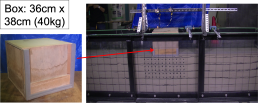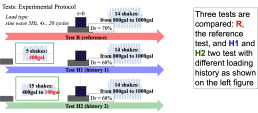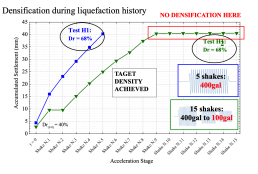Introduction: Shaking Table Tests / 序論: 振動台実験
It has been observed that recurrent liquefaction is a common issue in sites at risk and pose a serious threat to structures integrity. It is a general belief that densification of the soil induced by liquefaction increases its resistance and make the site safer. However, this might not always be the case. The test results compare the building movement in the case of no previous liquefaction and two other cases of previous liquefaction history.
同じ地盤が連続して液状化する再液状化は液状化危険性のある土地では一般的に見られ、周辺構造物に脅威をもたらす。一般的には液状化により地盤の密度が上昇するため、その結果液状化強度が上昇しその土地は安全となると信じられてきた。しかしながら、それは必ずそうとは限らない。本研究では液状化履歴のないケースと履歴のあるケースで構造物モデルの沈下や傾斜がどのように変わるかを比較する。
Shaking table apparatus and soil container / 振動台装置と地盤模型
Super structure in the shaking table model / 振動台に設置された地上構造物模型
Methodology of Study / 実験方法
A reference test (R) with no liquefaction history has been compared to tests that were subjected to previous shakes before the main load application. The test R was prepared at the target density by air pluviation. The structure was installed before any load was applied to the model. For the tests with liquefaction history, test H1 and H2, the soil was initially prepared at a loose density. The loading history was then applied, at the end of which the target relative density was achieved: here 70%. Once this part finished, the structure was installed in the model. Therefore, at the time of the structure installation, the different cases have the same density and geometry: the difference is thus due to the loading history.
液状化履歴を与えないケース(R)を本載荷の前に液状化履歴を与えたケース(H1, H2)と比較する。ケースRは目標の相対密度となるように空中落下法で作成された。構造物模型は振動を与える前に地盤模型に設置された。液状化履歴を与えたケースH1, H2では地盤は最初は緩めの密度で準備され、履歴加振後に目標の相対密度70%に達するようにした。履歴加振が終わった後構造物模型が地盤模型に設置された。したがって、構造物模型が立つ地盤は同じ密度であるが異なる履歴を持っており、その違いは加振履歴(=過去の地震や余震)により作られたものである。
Test experimental protocol for the comparative study / 比較実験概要
Same model density when the superstructure is installed / 地上構造物模型が設置された時に等密度である
Test results / 実験結果
As shown on the bottom right figure, the deformation resulting from the first dynamic load applied to the model was significantly different in all three cases. In the case H1, the loading history resulted in a settlement more important of the structure. Howerver, in the case H2, the settlement was greatly reduced. A major difference between the tests H1 and H2 lies in the shear strain history of the model: when the last double amplitude of the shear strain was large (10% for test H1) the deformation became worse. On the opposite for a small double amplitude of the shear strain (<1% for test H2), the deformation was greatly reduced.
右下の図の通り、3ケース全てで本加振による地盤の変形が大きく異なったことがわかる。H1ではより大きな沈下と傾斜が見られたが、H2ではH1と異なり沈下と傾斜が大きく削減された。H1とH2の違いは加振履歴の違いにある。H1では最後の加振でのせん断ひずみ振幅が大きく、本加振で大きなダメージを受けたのに対し、H2では最後の加振でのせん断ひずみ振幅が小さく、変形が大きく抑制された。





